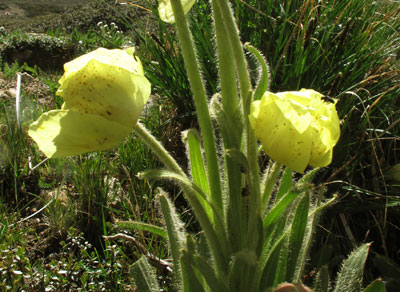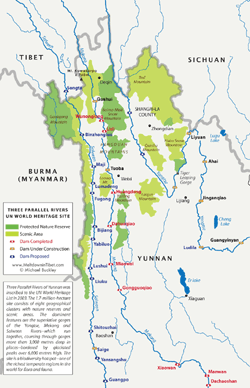In 2003, a region known as the Three Parallel Rivers was inscribed to the World Heritage List. According to the UN assessment, this region 'may be the most biologically diverse temperate eco-system in the world.' One with myriad species of plants and rare or endangered animals and fish. The three rivers referred to are the Yangtse, Mekong and Salween—running close together, roaring through deep furrows in this zone at the eastern edge of the Tibetan plateau. The micro-climates in these mountains host a huge range of flora, depending on altitude. Many ornamental plants in the West today derive from this species-rich region—species like azaleas, primroses and rhododendrons were collected by Western plant-hunters.
Recognition by UNESCO requires that there be no interference in the natural state of the region designated. But no sooner was this World Heritage Site confirmed than Chinese engineering companies announced plans for building large dams on the Salween. In April 2004, plans were announced for construction of a cascade of 13 large dams on the Salween, ranging from a wall height of 35 metres—to a whopping 307 metres (the height of a 60-storey building). The fact that some of these dams would be built within a protected UN World Heritage Site does not appear to be a contradiction to China's ruling powers. The Three Parallel Rivers World Heritage Site is protected—but the rivers that give the name to that site are not protected, it would seem.
Biodiversity and mega-dams are not words that go together. Dams are destroyers of biodiversity. What is happening in the Three Parallel Rivers region is no longer preservation of biodiversity: this is a case of bio-adversity. There are rumblings from international observers to place the Three Parallel Rivers region on the World Heritage in Danger List, since the dams—many of them under way—are seriously impacting the eco-systems.
Map of Three Parallel Rivers region, Kham, Yunnan:
The following is excerpted from an article by Jonathan Watts, in The Guardian, UK, 18 Jan 2011:
Last refuge of rare fish threatened by Yangtze dam plans
Developers of hydroelectric plant have redrawn the boundaries of a crucial freshwater reserve for rare and economically important species
The last refuge for many of China's rarest and most economically important wild fish has mere days to secure public support before it is trimmed, dammed and ruinously diminished, conservationists warned today. The alarm was raised after the authorities in Chongqing quietly moved to redraw the boundaries of a crucial freshwater reserve on the Yangtze, which was supposed to have been the bottom line for nature conservation in one of the world's most important centres of biodiversity.
The Upper Yangtze Rare and Endemic Fish Nature Reserve was created in the 1990s as a haven for species that were threatened by the Three Gorges dam, the world's biggest hydroelectric plant. Among the hundreds of species it protects are four types of wild carp that experts say are essential to China's food security because they provide the diverse genetic stock on which fish farms depend for healthy breeding. In recent years, the importance of this 400km-long ecological hold-out has increased as China's hunger for energy has driven power companies to build two more mega-dams — Xiangjiaba and Xiluodu — that have swamped the shoals and stilled the rapids along thousands of kilometres of Asia's biggest river.
Downstream, the combination of dams, pollution, overfishing and river traffic have decimated fish stocks, wiped out at least one species — the Baiji or Yangtze river dolphin — and left others — like the giant Yangtze sturgeon (Acipenser dabryanus), the Chinese paddlefish or the finless porpoise — critically endangered. Upriver, the state has promised to safeguard the last untamed stretch. A coalition of scientists and conservationists has opposed development in the reserve. Premier Wen Jiabao has expressed unease about the impact of excess dam-building on environmentally important areas.
But this goal has run up against the interests of the Three Gorges Project Development Corporation and local officials, who want to build yet another hydroelectric plant at Xiaonanhai that would choke the river to power the development of the poor local economy. The developers appear to have gained the upper hand last week when the Ministry of Environmental Protection announced plans to redraw the boundary of the reserve so that it would no longer encompass the area of the proposed dam. This leaves less than 10 days for public discussion, according to conservationists who are dismayed there has been almost no domestic coverage, partly because many of the 29 endangered fish species — such as Chinese paddle, Yangtze sturgeon and Chinese sucker — are unknown outside of expert circles.
"This is the last hold-out for much of China's freshwater biodiversity. It is a rare situation when one project can do so much damage," said Ma Jun of the Institute for Public and Environmental Affairs, one of the country's leading green campaign groups. "Part of the problem is that unlike pandas, snub-nosed monkeys or Tibetan antelopes, most people have not heard of or seen the fish affected."
Local government insists no decision has been made on the dam, but past precedent suggests that construction will begin before the formal environmental impact assessment is made, by which time developers will argue that it would be a huge waste of money to cancel.
Less often calculated is the economic loss of biodiversity. With fewer wild carp to bolster farm stocks, environmental experts say China is taking a risk with a primary source of protein. Since the Three Gorges was built, the downstream carp population has crashed by 90%, according to Guo Qiaoyu, Yangtze River project manager at The Nature Conservancy.

